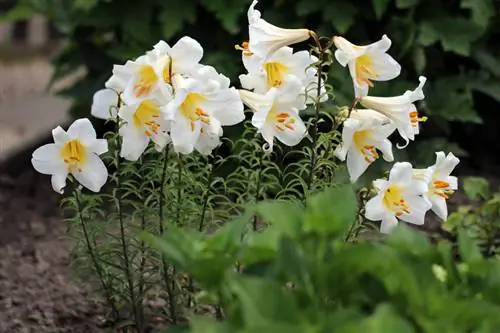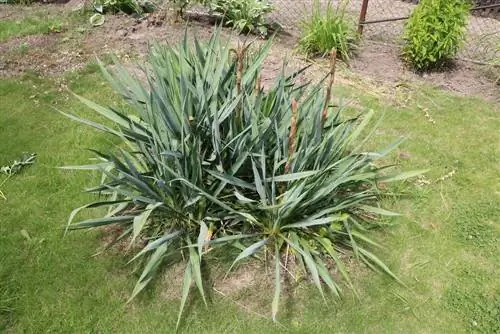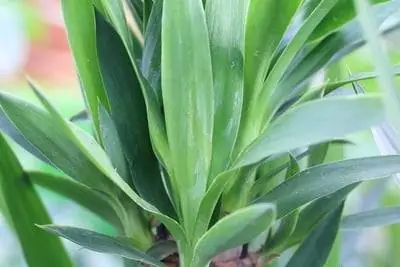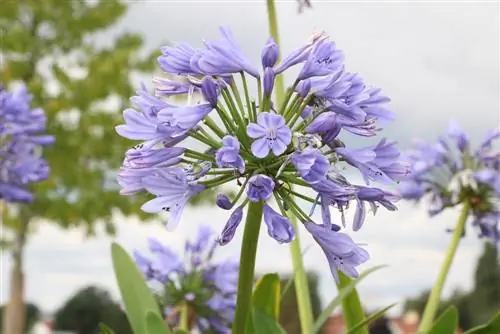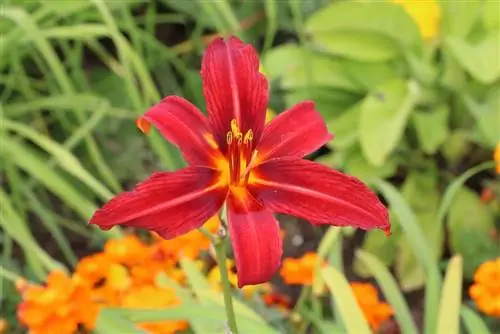- Author admin [email protected].
- Public 2023-12-17 03:39.
- Last modified 2025-01-24 12:45.
The Madonna lily, originally from the Mediterranean region, is still a well-known symbol of innocence and purity, which is particularly due to the striking white flower funnels.
Information on the Madonna lily
- Growth height: 80 to 150 centimeters
- Growth habit: upright
- Leaves: summer green
- Leaf shape: elongated
- Leaf color: green
- Flowering period: June to July
- Flower shape: multi-flowered funnels
- Flower characteristics: strongly scented, long pistils
- Flower color: white
- Toxicity: No
Location Requirements
In keeping with its natural occurrence, the Madonna lily prefers a sunny location protected from wind and rain. To avoid burning the delicate flowers, the flower should not be exposed to the blazing midday sun. However, a location that is too shady leads to reduced flower formation and an overall weaker immune system of the flower.
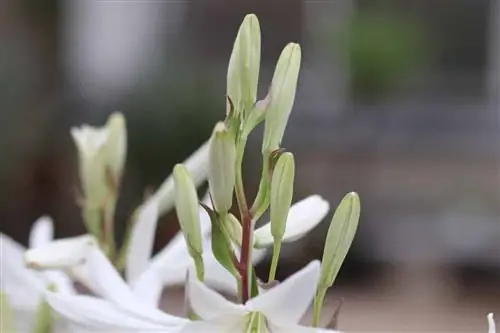
The soil substrate in which the onion is placed should have a permeable, nutrient-rich and sandy consistency. This is essential to avoid waterlogging, which in the long term leads to rotting processes on the onion. In addition, Lilium candidum prefers a basic pH value and is extremely tolerant of high lime content.
The following are particularly suitable for putting together your own substrate mixture:
- Sand
- clay
- gravel
- Peat
- Humus
Tip:
In order to meet the high demands of the lily, a location near a wall or hedge has proven useful in practice, which offers optimal protection from the weather but also meets the need for warmth.
Planting partner
Due to their striking flower shape and large height, low-growing plants are particularly suitable as secondary plants. In addition, the supplementary planting serves to conceal the often bare stems of the Madonna lilies and, when combined with colorful flowering plants, creates a harmonious arrangement all year round.
Suitable planting partners for bed and container cultivation are:
- Brandkraut
- Monkshood
- Ball Thistle
- Lavender
- Purple Coneflower
- Drumstick leek
- Ornamental millet
Planting
Compared to many other types of lilies, the optimal time for planting the Madonna lily is in August. When it comes to planting time, it is irrelevant whether the flower is planted in a bed or a pot. In order to promote root growth, especially in the early stages, it is recommended to apply a root fertilizer to the planting hole before planting the onion. When planting in beds, the individual bulbs should be planted at least 30 centimeters apart and no more than five centimeters deep in the soil. Under no circumstances should the top of the bulb be completely covered with soil. A slight arch is recommended for the top layer of soil to avoid standing moisture and to support the drainage of water.
Note:
Lilium candidum tolerates transplanting very poorly and therefore prefers a permanent location that should only be changed every three to four years or in the event of a pest infestation.
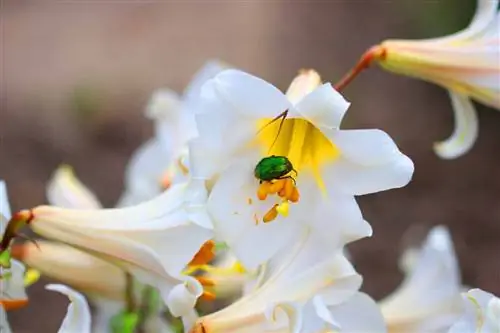
Propagation
The Madonna lily is propagated exclusively via the bulb. Many of the lily species available today do not produce seeds that can reproduce, which is why they cannot be propagated this way. In addition to the separation of trained breeding onions, propagation via individual onion scales has also proven successful in practice. Since the onions often only develop after several years, the second option offers a much faster propagation method.
The process for propagation is ideally as follows:
- Sterilize and sharpen knives
- Prepare the container with potting soil and lime
- Cut off the onion scales with part of the onion base
- Place the separating piece in moist potting soil
Irrigation
Lilium candidum requires consistent watering, as it cannot tolerate both persistent drought and waterlogging. Waterlogging in particular leads to putrefactive processes over a short period of time, which can be avoided by dividing the watering into several smaller doses. This danger should not be underestimated, especially with potted plants, which is why water drainage should be supported by means of a drainage layer made of stones and drainage holes on the underside.
In addition, you should avoid watering the leaves and flowers during midday or from above to prevent burns on them.
Tip:
Ensure sufficient watering even during the winter period, otherwise the Madonna lily will dry out. However, to avoid frost damage, watering should only be done on frost-free days.
Fertilization
Organic fertilizers, which are dug into the surrounding soil once a year, are particularly suitable for fertilizing the Madonna lily. The following fertilizers have proven to be particularly effective in practice:
- Compost
- rotten crap
- Horn shavings
- Stinging nettle manure
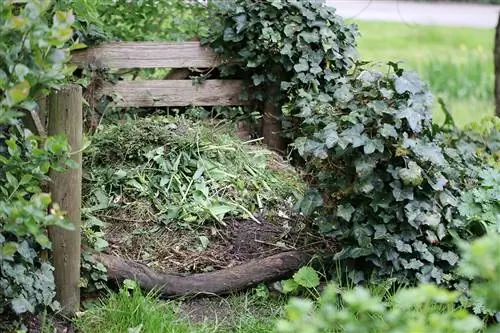
The ideal time to apply fertilizer is spring. Fertilization in autumn should be avoided if possible, as this contributes to increased growth during the winter period, which the plant bulb actually needs as a resting phase.
Cut
After the entire flower has faded, radical pruning is essential to enable the bulb to develop new shoots. To do this, the dried shoots are cut back to the bulb. During the year it is also advisable to regularly remove the individual dried-out areas. These continue to deprive the plant of nutrients and also represent an ideal target for pests.
Only clean and sharp tools should be used for the work to reduce the risk of pest or disease infestation.
Tip:
Due to its strong height growth, the Madonna lily quickly reaches a size that requires the flower to be supported. An ordinary wooden stick to which the plant is attached using a ribbon is suitable for this.
Wintering
For specimens of the Madonna lily that have been transplanted outdoors, applying an additional layer of mulch or brushwood over the winter is completely sufficient as a protective measure. In contrast, onions grown in pots require additional frost protection to prevent the substrate from freezing. In the worst case, this leads to the death of the root ball and thus the entire plant. Therefore, when overwintering potted plants, it is recommended to move them to a frost-free winter quarters that should have a temperature of eight to twelve degrees and sufficient brightness. If the bucket is to be kept outside over the winter, the following materials should be used to cover the bucket:
- Wood
- Styrofoam
- Jute
- brushwood
- Straw
Diseases and pests
Anyone who knows and recognizes the threats and dangers to the Madonna lily can combat them more quickly and thus help the plant stay he althy.
Root rot
The main cause of root rot is a location that is too moist in conjunction with a cool outside temperature. These conditions favor the proliferation of fungi and bacteria, which are deposited on the roots and bulb of the Madonna lily itself and thereby remove nutrients from the plant. This subsequently leads to reduced growth and wilting of leaves and flowers despite adequate watering overall. An effective fungicide against root rot is not yet known, which is why the following relocation procedure is the only option.
- Dig up onions
- cut back rotten areas generously
- let he althy plant parts air dry for a day
- Transplanting to a new location
- Stop watering for another week
Lily Chicken
The lily hens are reddish beetles that attack Lilium candidum and other onion plants, especially in spring. The larvae of the insects eat the plants until they are completely cleared and, if discovered too late, lead to their death. It is therefore advisable to regularly check the flowers in spring for the visually conspicuous beetles and to rinse them off using a strong jet of water. The undersides of the leaves in particular should not be ignored, as the eggs are usually laid there.
Other proven home remedies for lily chicken are:
- Applying coffee grounds, algal lime or rock powder
- Spraying with a mixture of water, soap and ethanol (ratio 4:2:1)
- Chives as planting partners
- Support the settlement of natural predators, such as birds
Snails
Similar to an infestation with lily chickens, a snail infestation of the Madonna lily is also characterized by eaten leaves and a bald plant shape. However, due to their size, they are much easier to remove by hand and move to another location. In addition to distributing biological slug pellets, spreading coarse sawdust, which forms a natural barrier, has proven useful in practice to protect against reptiles.
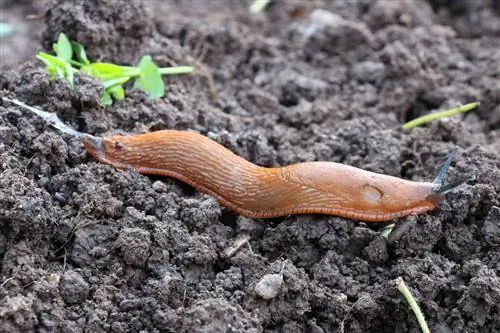
Voles
As pure vegetarians, the voles feed exclusively on plants. The preferred food sources include tuber and onion plants, which are eaten by the animals, which predominantly live underground. An infestation is therefore often difficult to detect on the plant itself above ground. The typical vole burrows, which are restored within a very short time if they are destroyed, allow a clear demarcation from the mole burrows. The easiest way to combat this is to catch the mice using a food trap filled with a preferred vegetable such as celery or carrots.

